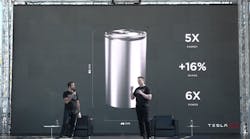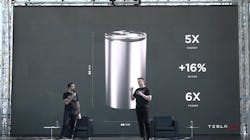EV makers have been waiting for a renaissance in battery technology seemingly longer than the peoples of Europe waited for the cultural, artistic, political, and economic rebirth following the Middle Ages. But with battery suppliers squeezing out only incremental advances in cell design, chemistry, performance and manufacturing, Tesla is taking matters into its own hands.
That’s not to say the company is abandoning its battery partners Panasonic, LG, and CATL. But as Drew Baglino, Senior VP, Powertrain and Energy Engineering, and CEO Elon Musk revealed at the company’s recent Battery Day, Tesla plans to upgrade just about every aspect of battery performance and production on its own.
Since, like the rest of us, you’ve waited long enough for battery tech progress, let’s not make you wait a minute longer.
The key points: Tesla will begin in-house battery-cell manufacturing. The new cells are designated 4860 and are bigger than what the company has used before; they will have a “tabless”’ design; and they will employ a dry electrode relying primarily on nickel. The cells will also be integrated into the vehicle as an entirely structural component. What’s more, Tesla has a plan to halve the cost per kilowatt-hour of the battery packs it produces.
All told, the series of planned advances is expected to yield a 54% increase in range, a 56% decrease in the dollar per kilowatt-hour at the battery-pack level, and a 69% reduction in capital investment per gigawatt-hour required for manufacturing.
It will take Tesla probably a year to 18 months to start realizing these advantages. And to fully realize these advantages, probably “about three years or thereabouts,” according to Drew Baglino and Elon Musk.
Tesla’s plan isn’t one that rests on a single innovation. Rather it stretches across every facet of what makes a cell into a battery pack, from raw material to the finished product. Let’s look at these technologies one at a time
A Bigger Cell
The larger 4680 cell is a new “tabless” design with contacts running the length of the anode and cathode sheets. It will hold five times more energy, generate six times more power, and allow for an extra 16% range.
In operation, lithium ions in a battery pack are moving from anode to cathode. And then the reverse happens when the cell is charged, lithium moving from cathode to anode across the separator. This is the basis of lithium-ion batteries, no matter the form factor.
But while most EVs have been built with flat pouch or prismatic cells, Tesla uses a cylindrical cell. In the cylindrical cell, there’s a cap and the can—negative and positive terminals of the cell where anodes, separators, and cathodes are rolled-up sheets packed into a cylinder-shaped housing.
When you open that cell, there’s a tab connected to the terminals—what Tesla calls the jelly roll—which is the wound electrodes on the inside. When unwound, it’s over a meter long in a typical Tesla 2170 cell in its Model 3. In Tesla’s battery nomenclature, the first two digits of the cell number refer to the cell diameter (in this case 21 mm), and the second two digits refer to the length (70 mm), so it involves quite a long winding process.
Range increases if you change the outer diameter of the cell. Tesla says the sweet spot is somewhere around 46 mm. But it’s not just about a bigger form factor, since problems arise as you make cells larger. In fact, fast “supercharging” and thermal considerations become challenging with bigger cells.
Tesla’s solution was to develop a tabless architecture that “removes the thermal problem from the equation and allows us to go to the absolute lowest-cost form factor and the simplest manufacturing process,” said Baglino.
The tabless architecture takes the existing foils, laser patterns them, and enables dozens of connections into the active material through a spiral. This results in simpler manufacturing, fewer parts, and, importantly, a 50-mm versus 250-mm electrical path length, which delivers the thermal benefits. There’s a shorter path length in a large tabless cell than in the smaller cell with a tab, Tesla noted, and the power-to-weight ratio is said to be actually better than the smaller cell with tabs.
How does Tesla plan to make a tabless cell and connect it to the top cap? “We’re keeping a little secret sauce here that we’re not telling anyone,” said Musk.
Getting rid of the tabs also dramatically simplifies winding and coding because when the cell is going through the system, it has to keep stopping at each tab. “So you can’t do continuous motion production if you have tabs,” said Musk.
When it’s all put together, the new 8-mm-length 4680 cell is expected to yield five times the energy with six times the power, in addition to a 16% range increase and a 14% dollar per kilowatt-hour reduction, just in the cell form-factor change.
Tesla is starting to ramp up manufacturing of these cells at a 10 gigawatt-hour pilot production facility. It will take about a year to reach the 10 gigawatt-hour capacity, noted Musk. The actual production plants will be more on the order of perhaps 200 gigawatt-hours, according to the company.
Because the batteries are solid, Tesla can actually use the steel shell case of the battery to transfer physical loads from the upper and lower face sheet. This makes for an incredibly stiff structure, even stiffer than that of a regular (gasoline-powered) car.
The Cathode: A Stable Bookshelf
The simple description of a cathode is that of a bookshelf stable enough to keep the books (ions) moving on and off. The metal—the nickel, cobalt, manganese, or aluminum—is the shelf, and the lithium is the book. What sets apart these different metals is how many books of lithium they can fit on the shelves and the sturdiness of the shelves.
The cathode process is a big target for Tesla—35% of the cathode dollar per kilowatt-hour is just in transferring it into its final form. Effectively, you start with the metal from the mine, which is changed into metal sulfate “because that just happened to be what chemists wanted a long time ago,” said Baglino. “And then when you're making the cathode, you have to take this intermediate thing called metal sulfate, add chemicals, add a whole bunch of water, and at the end, you get that little bit of cathode and a whole lot of wastewater and other by-products.
Tesla wants to get rid of the intermediate steps and have no wastewater at all. Said Musk, “And when you summarize all of that, it's a 66% reduction in CapEx investment, a 76% reduction in process cost, and zero wastewater—a much more scalable solution.”
While nickel may be the cheapest and highest energy-density material for cathodes, cobalt is often used because it is “a very stable bookshelf.” And the challenge with going to pure nickel is stabilizing that bookshelf with only nickel, “and that's what we've been working on with our high-nickel cathode development, which has zero cobalt in it, said Baglino. By leveraging novel coatings, “we can get a 50% reduction in cathode dollar per kilowatt-hour,” he added.
Musk said Tesla will start producing cathodes in America, reducing the distance travelled by these materials by 80 per cent, which is huge for cost purposes. The company will also employ a sulfate-free lithium integration process, reducing the cost of lithium by a third.
As an interim step, Tesla plans to use nickel manganese. Baglino pointed out that it’s relatively straightforward to do a cathode that's two-thirds nickel, one-third manganese, “which would then allow us to make 50% more cell volume with the same amount of nickel.”
Cathode production would be part of the Tesla cell production plant. “Now that we have this process, obviously we're going to go and start building our own cathode facility in North America and leveraging all of the North American resources that exist for nickel and lithium,” said Musk.
The way lithium ends up in the cell is through the cathode. So obviously the executives said Tesla then should perform on-site lithium conversion as well, which is what they’re going to do, using a new sulfate-free process. Again, skip the intermediate steps, resulting in a 33% reduction in lithium cost from a facility co-located with the cathode plant.
Tesla engineers asked themselves “what is the smartest way to take the ore and extract lithium in an environmentally friendly way?” Said Musk, “We actually discovered, again looking at first principles, that instead of just the way it's always been done, we can actually use table salt, sodium chloride, to basically extract the lithium from the ore. To the best of my knowledge, nobody's done this before. All of the elements are reusable. It's a very sustainable way of obtaining lithium. And we actually have rights to over 10,000 acres of lithium clay deposits in Nevada. Simply mix clay with salt, put it in water, and the salt comes out with the lithium. Done.”
The Anode: Using Raw Silicon
A Li-ion battery is an intercalation system, in which both cathode and anode present structures that allow reversible insertion and extraction of Li+ lithium. Raw silicon stores nine times more lithium than graphite, which is the typical anode material in lithium-ion batteries today. So why isn't everybody using it? The main reason is because the challenge with silicon is that it expands four-fold when fully charged with lithium and that can damage the cell. Tesla will use raw silicon and then add a special coating that will allow for expansion.
What Tesla wants to do is to start with raw, metallurgical silicon, then stabilize the surface with an elastic ion-conducting polymer coating that’s applied through what they say is a very scalable approach. No chemical vapor deposition will be used. And in the end, by leveraging this silicon to its potential, the range of vehicles will be increased by an additional 10% as well as 5% dollar per kilowatt-hour anode cost reduction at the battery-pack level.
Electrode Coating: From Wet to Dry
One of the most important processes is the wet process of the electrode coating. First the powders are mixed with either water or a solvent (for the cathode). That mix then goes into a large coat and dry oven where the slurry is coated onto the foil, dried, and then that solvent must be recovered. Lastly, the coated foil is compressed to its final density.
Tesla plans to skip the solvent step and just go straight to a dry coating mix—literally powder into film. Musk pointed out that the company acquired the energy-storage company Maxwell Technologies a little over a year ago, and they had what Musk described as a “proof of concept.” Since the acquisition, Tesla has ramped up the machine that does dry coating four times and “we are not there yet,” he said. “It is close to working. It’s fair to say probably it does work, but with not a good, high yield.”
Musk added, “We’ll probably be on machine revision six or seven by the time we do large-scale production. The rate at which the machines are being improved is extremely rapid. Literally every three or four months, there’s a new revision”.
Coming: A Cheaper Tesla
In other news, Musk spoke of a $25,000 Tesla car, which doesn't have a name yet and is coming in three years. Another highlight of Battery Day was Elon Musk unveiling the new tri-motor AWD Plaid Model S with more than 520-mile range, 1100 horsepower (not a typo), 200-mph speed, 0- to 60-mph acceleration in less than two seconds, and a lofty $139,000 price tag.
Long term, Musk wants to try to replace about at least 1% of the total vehicle fleet on Earth, which is about two billion vehicles. “So long term, we want to try to make about 20 million vehicles a year,” he said.

